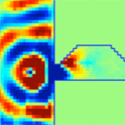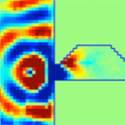An invisible gateway
In 2009, a team of researchers led by Che-Ting Chan at the Hong Kong University of Science and Technology theorized on using transformation optics and complementary media to produce optical illusion devices that change the optical response of an object into that of another object. Illusion optics, the science of making an object appear as something else, or reappear elsewhere in space, or even disappear altogether (cloaking) is full of exciting possibilities, pending experimental realization.
In a paper in Physical Review Letters, Chao Li and co-workers at the Chinese Academy of Sciences, Beijing, and colleagues at Soochow University, China, and Hong Kong University of Science and Technology, experimentally demonstrate the first illusion-optics device. They trick light to miss an open channel across a slab at a frequency range of interest, rendering the channel into an electromagnetically invisible gateway. Li et al.’s design involves carving out an open channel across a metamaterial slab that behaves as a perfect electric conductor, then replacing a trapezoidal region of the slab adjacent to the channel with another metamaterial having the exact opposite dielectric properties. This “double-negative” region complements the dielectric space inside the channel into an optically equivalent region that behaves as a perfect electric conductor, thereby giving the appearance of a blocked gateway to light that attempts to go through.
Li et al. use a transmission-line approach that allows them to design metamaterials with the desired optical properties and with minimal losses. Their illusion-optics prototype works at around and has a bandwidth. – Manolis Antonoyiannakis





